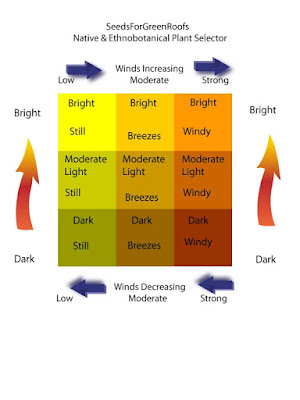Understanding how your rooftop garden or green roof plants - vegetables, native plants or other - are impacted by light and wind is very important.
Recall from previous posts, discussions about identification and boundary delineation of roof areas according to levels of available light and present wind loadings. The roof under consideration was sectioned off on a five meter grid and assigned design levels of wind and light influence according to the following simplified diagram. Light and wind can be considered the two primary design factors.
 |
| Green Roof Design Diagram |
This is not to say the secondary design variables are not important, as they are. Secondary green roof design variables include:
- Climate and Weather
- Rainfall
- Non-Rainfall Air Water Vapor and Humidity
- Dew, Types of Fog and Frost
- Smog
- Temperatures
- Adjacent vegetation
- Nearby Allopathic Plants
- Adjacent Exotic Invasive Species, and
- Local Seed Source
Though not used to determine the roof polygon boundaries, the secondary variables play an important role within a design model considerations and we will discuss those interactions in detail in future sections.
Importantly, certain light wavelengths are required for photosynthesis. Without light photosynthesis does not occur and plants do not grow. Light is the first primary design variable to be considered when creating roof ecosystem polygons.
Wind is the second of the primary design factors used to determine roof ecosystem polygons.
Though ambient outside air temperatures, precipitation, air quality and other design variables are generally consistent across the roof, light availability and wind effects can change depending upon where one stands on the same roof. Both light and wind are critical factors in designing a green roof for dry and arid climates. Without adequate light plants will not live and consistently buffeted by desiccating winds plants may cease to transpire and quickly die.
Understanding how wind and light impact the green roof can afford the designer the capability to predict plant growing success.
The following diagram suggests that the optimal growing space on green roofs and for rooftop permaculture lay in areas with moderate to strong sunlight and still to slightly moderate winds.
Finally, understanding the light and wind levels across the roof under consideration can help avoid so-called 'dead-zones'.
Dead zones are areas on the green roof subject to light and wind conditions beyond suitable for most C3 and C4 plants.
CAM and other hardy succulent plants are those most desired for roof areas identified as harsh, a result of too much light and/or too much wind.
Know your wind and light levels.
Your green roof plants will grow accordingly.
Understanding how wind and light impact the green roof can afford the designer the capability to predict plant growing success.
The following diagram suggests that the optimal growing space on green roofs and for rooftop permaculture lay in areas with moderate to strong sunlight and still to slightly moderate winds.
 |
| Green Roof Design Diagram |
Dead zones are areas on the green roof subject to light and wind conditions beyond suitable for most C3 and C4 plants.
CAM and other hardy succulent plants are those most desired for roof areas identified as harsh, a result of too much light and/or too much wind.
Know your wind and light levels.
Your green roof plants will grow accordingly.
No comments:
Post a Comment